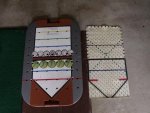There's been a great discussion of what bat drag looks like and what cues and movements help players and coaches understand it and start to correct it. I feel like I get these concepts and have spent time working with our players on slo-mo swings and tee work to get them to understand them as well.
But what drills would you all suggest to burn bat drag fixes into muscle memory? I have several thousand swings left this winter with our players, how best to use them to create muscle memory on live swings that will fix bat drag problems that almost all of our 1st year 12Uers have to some extent?
If you had a tunnel to dedicate or a time slot to run through 3-5 drills what would you recommend? Seems there's some consensus around hand-over. Would you recommend a barrier (such as a tee) behind the hitting tee? Or does that do more harm then good? Any gadgets you really recommend, like the Instructo Swing or Whip-It? What role do they play in the process?
And what about a progression, ie, start with these things and then move to these more advanced drills?
Thanks in advance.
But what drills would you all suggest to burn bat drag fixes into muscle memory? I have several thousand swings left this winter with our players, how best to use them to create muscle memory on live swings that will fix bat drag problems that almost all of our 1st year 12Uers have to some extent?
If you had a tunnel to dedicate or a time slot to run through 3-5 drills what would you recommend? Seems there's some consensus around hand-over. Would you recommend a barrier (such as a tee) behind the hitting tee? Or does that do more harm then good? Any gadgets you really recommend, like the Instructo Swing or Whip-It? What role do they play in the process?
And what about a progression, ie, start with these things and then move to these more advanced drills?
Thanks in advance.





